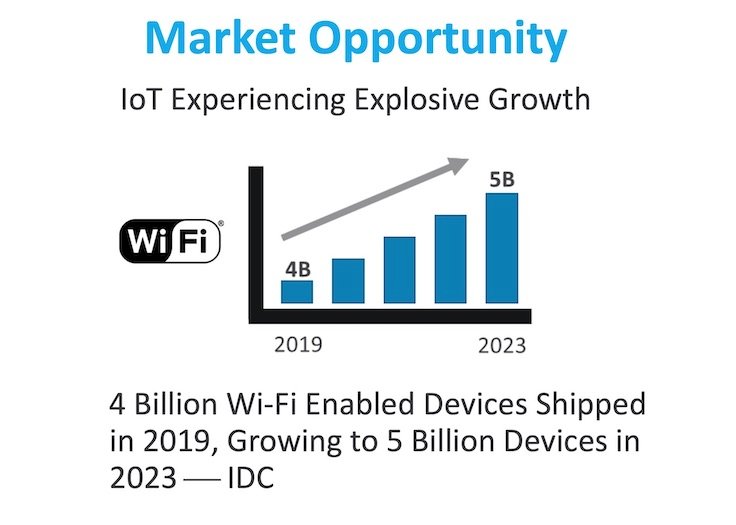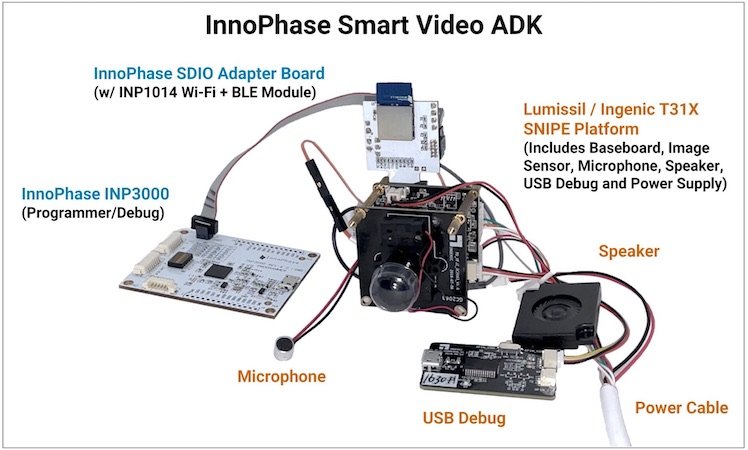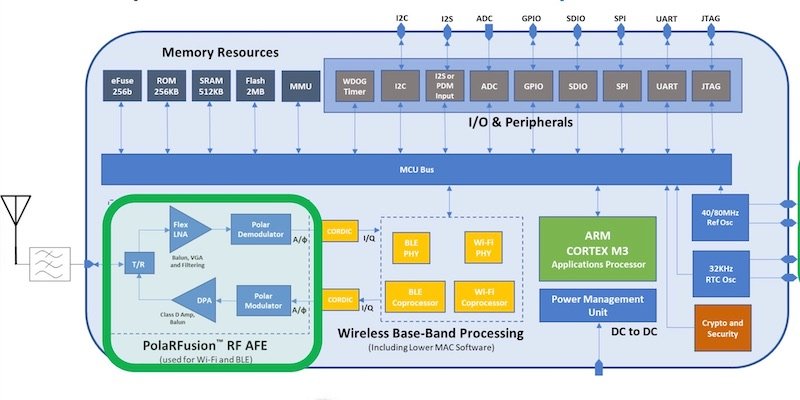Although Wi-Fi has been with us for a while, the standard itself was never designed with low power in mind. InnoPhase has addressed this issue with a different approach to RF wireless radio architecture with its digital polar radio implementation.
The company has integrated the radio into SoC and module solutions, and most recently into a Smart Video development kit.
In this article, we examine InnoPhase’s approach to RF Wi-Fi radio design, we discuss its SoC and dev kit solutions, and we share perspectives from our interview with Rob McCormick, senior director at InnoPhase.
Huge Market Growth for Wi-Fi Devices
The market opportunity for Wi-Fi-connected devices is huge, with market research firm IDC for its part forecasting up to 5 billion Wi-Fi-enabled devices by 2023. As new versions of the Wi-Fi protocol roll-out, throughput speeds keep increasing and new features are added.

Wi-Fi-enabled IoT devices are expected to see impressive growth to 5 billion devices by 2023.
Problem is that low power has never really been addressed in Wi-Fi. “In general, Wi-Fi didn’t come out of the gate to be low power,” says McCormick. “It was merely designed for wireless data communication. RF radio chip designs for Wi-Fi weren’t considering the issues of systems based on low-power sensors, and year-long battery lives.”
Indeed, power consumption is hindering several types of consumer Wi-Fi-connected Internet-of-Things (IoT) devices, says McCormick. Applications like video doorbells, security cameras, smart thermostats, wearables, and other applications face issues of short battery life caused primarily by RF radio that provides the Wi-Fi link.
“In general, optimization in the radio is really key to allowing this widespread adoption in the IoT and connected devices,” he says.
Digital Polar Approach to RF Radio Design
To address the challenges of low power, InnoPhase developed a new radio architecture. Its radio design is called “PolaRFusion,” and it takes a different spin on processing radio signals, says McCormick.
The implementation is digital polar radio. Instead of using Cartesian coordinates—an X and Y, or rather I and Q in wireless parlance—InnoPhase uses angle and amplitude. “It’s a different way of getting data points, but it’s the digital implementation of this that enables us to achieve our advantages in low power,” he says. “It’s what gives us flexibility and where we get the quick on and off that you would see in a typical MCU implementation.
The key element of the Talaria TWO SoC is the PolarRFusion block, which features a patented low-power digital polar radio design. (Click the image to enlarge)
InnoPhase took its PolaRFusion radio design and implemented it onto an SoC called Talaria TWO (“T2”). The RF radio is integrated alongside the complete functionality needed for IoT wireless IoT designs. For its processing core, the SoC embeds an 80 MHz Arm Cortex-M3, 512 KB SRAM applications processing. It has 2 MB of integrated, stacked flash memory and a full networking stack.
The T2 provides RF, baseband, PHY, and MAC functionality to support IEEE 802.11 b/g/n and Bluetooth Low Energy (BLE 5.0) standards. The T2 boasts a very low, always-connected current of 57 µA at DTIM10. DTIM10 refers to a delivery traffic indication map (DTIM), indicating the Wi-Fi message polling interval. Receive (Rx) current for the radio is rated at 31 mA, while transmit current is 129-178 mA at 14-18 dBm. More information is available on the T2 datasheet.
Smart Video Implementation Leverages T2 for Low Power
As an example of the T2 SoC platform put to use, last month InnoPhase announced a team-up with China-based Ingenic Semiconductor to jointly market a vision system. The vision system integrates Inginic’s T31 Video Processor with InnoPhase’s Talaria TWO INP101x Wi-Fi + BLE wireless modules.
The two subsystems are combined in InnoPhase’s Smart Video application development kit (ADK). Ingenic says it has successfully qualified the INP101x series of Wi-Fi + BLE modules and added them to its list of approved vendors. More information is available in the Smart Video ADK solution brief.

The Smart Video application development kit (ADK) combines Ingenic’s T31 Video Processor with InnoPhase’s Talaria TWO INP101x Wi-Fi + BLE wireless modules.
According to McCormick, the device results in a “freedom of placement” because of its extremely low power and wire-free functionality. This mix of battery-based video, Wi-Fi cloud connectivity, and AI processing is expected to open the door to new applications and services.
Examples include baby monitors, security cameras, video doorbells, access control, and identity verification, says McCormick. The lower-power Wi-Fi connectivity can enable batteries to last more than a year in these devices.
Wi-Fi Connectivity for an IoT Future
It’s important to remember that when IEEE rolled out its 802.11 Wi-Fi standard in the late ‘90s, the term “Internet-of-Things” didn’t exist and wouldn’t exist until over a decade later. Innovative approaches to Wi-Fi RF radio design such as those developed by InnoPhase help move wireless technology toward solutions that are better suited for long battery life IoT edge devices.
All images used courtesy of InnoPhase

